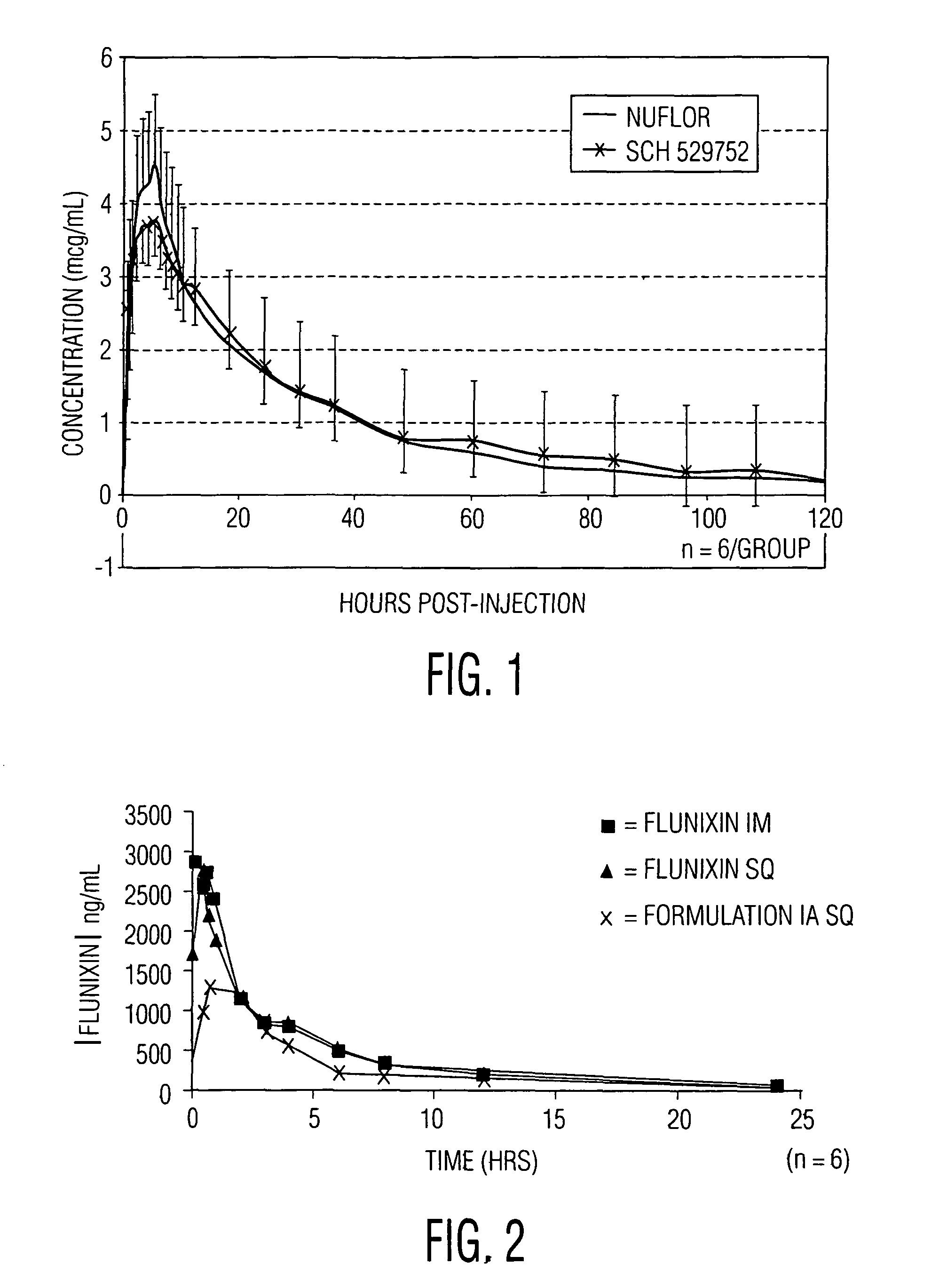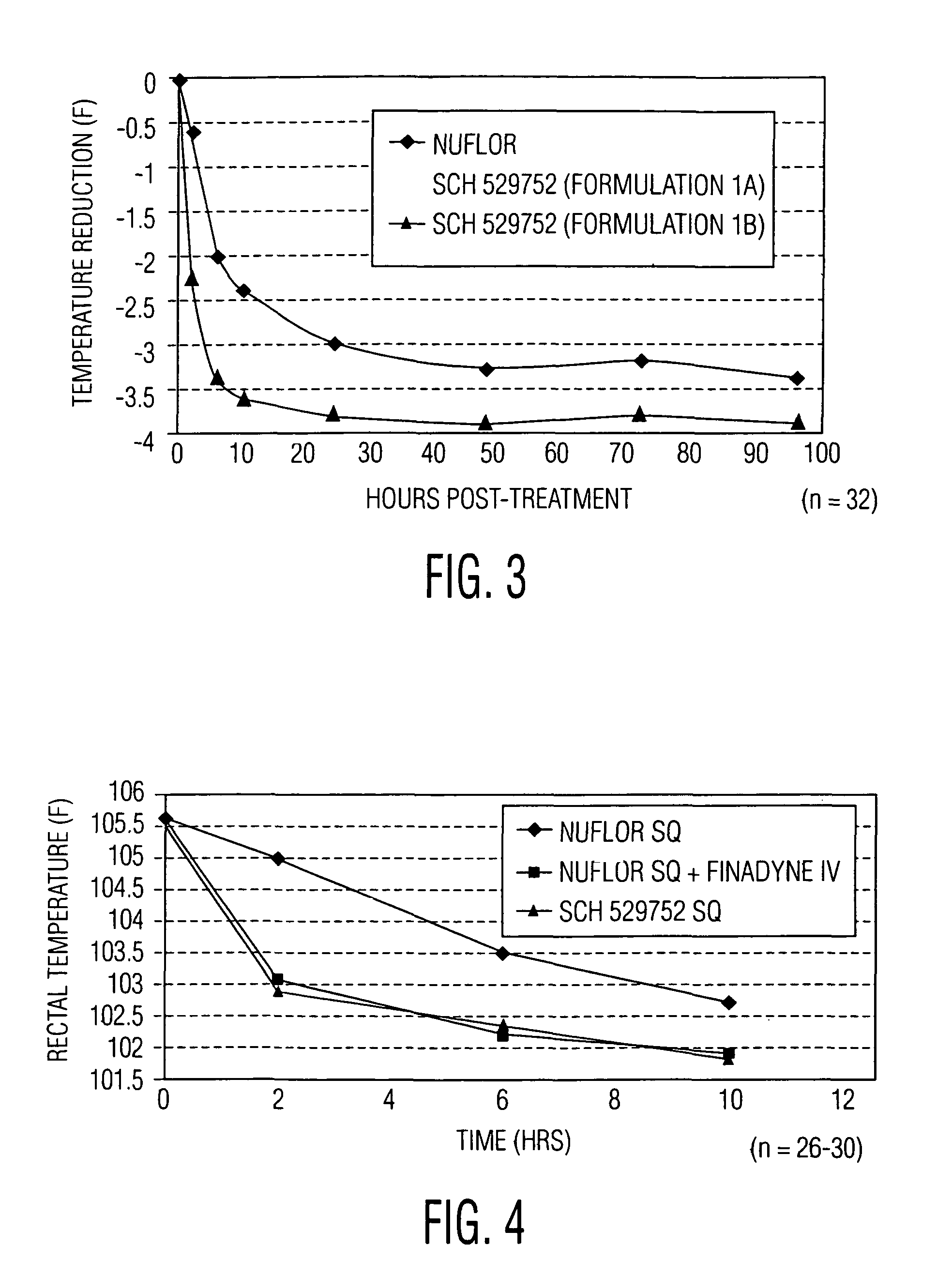Compositions and method for treating infection in cattle and swine
a technology for cattle and swine, applied in the field of compositions and methods for treating infection in cattle and swine, can solve the problems of economic loss to the cattle industry throughout, reduced weight gain, treatment and prevention costs,
- Summary
- Abstract
- Description
- Claims
- Application Information
AI Technical Summary
Problems solved by technology
Method used
Image
Examples
example 1
Florfenicol / Flunixin Combination Formulations
[0091]
Percent (w / v)Percent (w / v)Formulation 1AFormulation 1BFlorfenicol 300 mg / mlFlorfenicol 300 mg / mlIngredientFlunixin 16.5 mg / mlFlunixin 33 mg / mlFlorfenicol30.030.0flunixin meglumine 2.737 5.474N-methyl-2-pyrrolidone25.025.0propylene glycol15.015.0polyethylene glycol 300QSADQSADDensity 1.161 g / ml 1.167 g / ml
[0092]The N-methyl-2-pyrrolidone, propylene glycol and approximately 90% of the PEG 300 required were charged to the compounding vessel and mixed well. The florfenicol and flunixin meglumine were added with mixing until all solids were dissolved. The volume was adjusted with the remaining PEG 300.
example 2
Pharmacokinetics of Florfenicol in Combination Product
[0093]Formulation 1A of Example 1 (SCH 529752) was assessed in a pilot pharmacokinetic study involving 12 cattle in which 6 received florfenicol (NUFLOR) subcutaneously and 6 received Formulation 1A subcutaneously. A dose of 40 mg / kg of florfenicol and a dose of 2.2 mg / kg of flunixin was used. The results are shown in FIG. 1. This preliminary study provided good evidence that the pharmacokinetics of florfenicol, the formulation of the present invention, are very similar to that provided by the already-marketed product, NUFLOR.
example 3
Pharmacokinetics of Flunixin in Combination Product
[0094]In a second study, the pharmacokinetic profile of the second active component in Formulation 1A, flunixin, was examined. The pharmacokinetic profile of flunixin was evaluated following administration to cattle as the approved single entity flunixin meglumine product, FINADYNE, and as the combination product Formulation 1A. This study was conducted in four phases using six cattle (3 males, 3 females). All animals received FINADYNE intravenously (IV) in the first phase. This was followed, after a washout period, by the administration of FINADYNE intramuscularly (IM) to 3 cows and FINADYNE subcutaneously (SQ) to 3 cows. In the next phase the animals were crossed over and received FINADYNE IM or SQ. In the final phase, all six cattle received the flunixin / florfenicol combination product (Formulation 1A). All animals received flunixin at a dose of 2.2 mg / kg, regardless of the formulation or route of administration.
[0095]Blood sampl...
PUM
| Property | Measurement | Unit |
|---|---|---|
| body weight | aaaaa | aaaaa |
| body weight | aaaaa | aaaaa |
| body weight | aaaaa | aaaaa |
Abstract
Description
Claims
Application Information
 Login to View More
Login to View More - R&D
- Intellectual Property
- Life Sciences
- Materials
- Tech Scout
- Unparalleled Data Quality
- Higher Quality Content
- 60% Fewer Hallucinations
Browse by: Latest US Patents, China's latest patents, Technical Efficacy Thesaurus, Application Domain, Technology Topic, Popular Technical Reports.
© 2025 PatSnap. All rights reserved.Legal|Privacy policy|Modern Slavery Act Transparency Statement|Sitemap|About US| Contact US: help@patsnap.com



